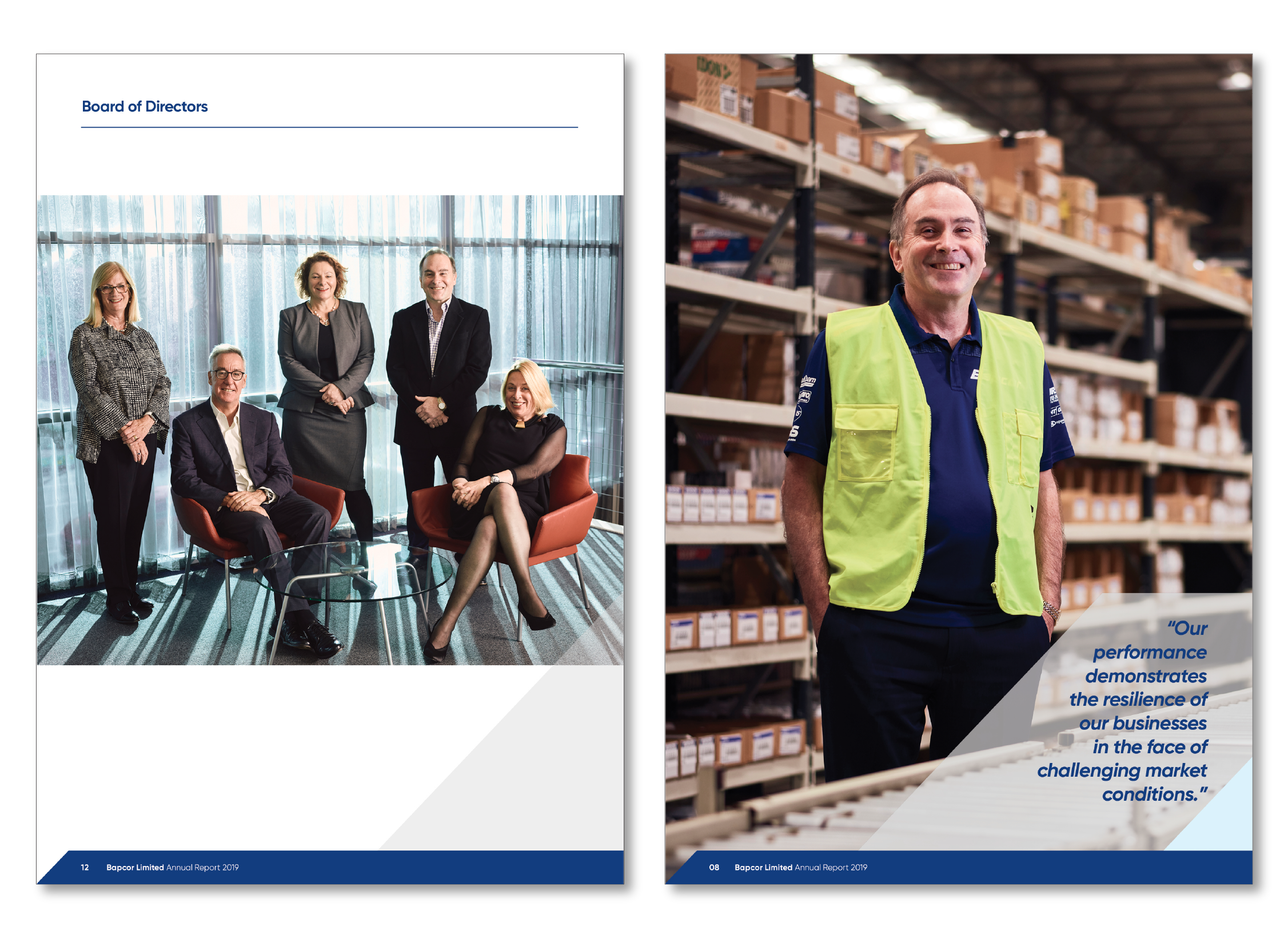01. The Brief
02. Strategy
03. Digital
04. Submissions
05. Budgets
06. Project Management
07. Design
08. Writing
09. Illustration
10. Photography
11. Production
12. Benchmarking
13. Fact Sheets
About
Contact
10. Photography
Images are the postcards that tell your story. Good use of high-quality, creative photography will engage your audience, and showcase your achievements and the people who helped make them happen.
Best practice
Key points:
- Prepare a clear brief detailing the scope of images to be produced.
- Will the final images be uploaded to the company website or used on other marketing items?
- Facilitate a briefing with the designer and photographer to ensure they have a clear understanding on the style of photography.
Using photography
There are two ways of using photography:
- The first is to purchase copyright-free, royalty-free or rights-managed photography. There are a myriad of websites that offer all types of photography. The positives are that they are extremely professional, available instantly and copyright/royalty free. The negative is that you cannot control who else is using the same photography or when – hence a competitor could publish the same photograph for the same purpose at the same time. It is a risk.
- The second is to commission a photographer to shoot to suit your brief.
If you have very specific requirements you can prepare a brief for a the photographer as part of the initial design brief. The brief will need to cover a range of areas that are specific to the shoot such as location issues, number of shots, type of shots etc.
Download a guide to briefing a photographer fact sheet.

Photographers
There are a number of ways to work with a photographer:
The designer includes photography within their design proposal. They will try to find some images that compliment their design – it will probably not be the ‘actual’ photograph but a sample of the same technique, or colourway, or shape.
It’s important to analyse the design and photography separately to decide if they fit the brief. The design direction may be approved, but the photography technique may not be liked/appropriate. In this case, a discussion about types of photographs and likes and dislikes should help resolve the issue.
At this stage it may be useful for the designer to submit a few alternatives for discussion, but the selection should be viewed as part of the design direction.
Photographers have a direct relationship with the client – they may be shooting the directors or board for the corporate governance section of the report, or perhaps they are on-site to shoot samples for a case study. In this case the designer should meet with the photographer to brief them on the style of photography.
The designer has a photographer with whom they feel most comfortable. Ask to meet them, and view their work. A quick discussion about corporate culture will usually be enough to tell if there is a future working relationship. In this discussion it will be necessary to get a feeling for how the photographer will work with people such as your executive and board.
Once the design direction and the photographer are approved, the photographic brief needs to be honed. This may be done directly with the photographer, or the designer may choose to be the intermediary – it depends on the project and the amount of involvement the client expects.
Decisions need to be made on how you are going to use the photographs. Use will dictate cost.
Whether the designer is to be present at each shooting session needs to be discussed because there may be implications on budget. Whilst being present for board/director shots may be wise, it may not be necessary for location shots. In fact some designers brief their photographer closely, then give them freedom to shoot solo. This can have huge logistical and economical savings, and often comes with the confidence of a long working relationship. Other designers prefer to art direct each and every shot. Their art direction fee should be written into the estimate.
Buying photography
Photographers do hand over copyright of their images. This needs to be discussed at the start of the project, as well as how many shots are to be purchased.

Photographers working on Annual Reports will shoot digital. Digital photographers shoot in a ‘raw’ program because they retain the maximum level of detail. The shots may uploaded to a website as proof sheets for selection by the designer and/or client. The selected shots are then ‘tweaked’ before being supplied. This can include labour intensive tasks such as colour calibration and adjustment of tonal balance. It takes time because shots are individually treated.
The ‘base’ cost should include a specified quantity of photographs finished to a reproduction standard, but this should be confirmed in early discussions. It should also be discussed whether the ‘out takes’ will be available on CD. Some photographers would rather not release them because they are not up to reproduction standard – others will ‘batch’ process them, not putting the same care into individual shots, but upgrading them to a lower standard.
All of this should be clarified in the photographic brief.
Copyright and photographers
The ultimate source for detailed information on this topic is the Australian Copyright Council.
Their factsheets are valuable tools. Below are some of the key points from INFORMATION SHEET G11 Photographers and copyright.
Key points:
- Generally, the copyright in photographs lasts for the life of the creator plus 70 years.
- Ownership of photographs varies depending on the circumstances under which they were taken.
- You will not own copyright just because you own the camera.
- Photographers also have moral rights in relation to their works.
What does copyright protect?
Copyright protects a range of materials, including photographs.
Copyright does not protect information, ideas, styles or techniques. For example briefing a photographer to take a particular shot with specific lighting techniques does not give you copyright over the image.
Protection is free and automatic
There is no system of registration for copyright protection in Australia. Copyright protection does not depend upon registration, publication, a copyright notice, or any other procedure – the protection is free and automatic.
A photograph is protected by copyright automatically from the moment it is taken.
The copyright notice
The copyright notice is not required for protection in Australia and in most other countries.
Download a guide to who owns copyright fact sheet?